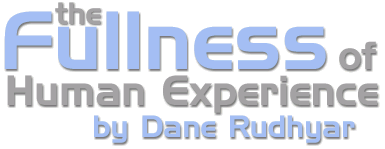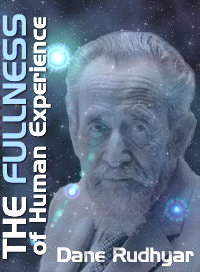 |
| Home | Bio | Art | Music | Literature | Civilization & Culture | Philosophy of Wholeness | Theosophy & Spirituality | Astrology |

CHAPTER NINE
The "Dangerous Forties" in the Life-Cycle of Humanity - 4 Service versus profit An individualistic society is today a profit-oriented society, because the profit-motive is attached indelibly to the current concept of individualism and even of what is ambiguously called human rights. The individual is, as a matter of course, expected to make profits from his or her activities; and profits become the "possession" of the individual acquirer. To possess is an extension of to be; it is the proof of being, even if it refers only to the "possession" of a body. The use of the body brings profits to the being who, as an individual subject, "owns" that body — a source of potential energy. But the subject has to feel somehow separate from the object he possesses if he is intended to use it. Use is understood in terms of acquired profit to the person identifying with his or her central reality, the ego. The ego — I myself. Peter or Jane — is the central reality in a society still dominated by an eighteenth century kind of abstract individualism, because the ego's ability to make free choices is considered the essential factor in any truly human situation. The mention of "free choice," however, is quite meaningless, unless one states the motive for the choice, and what factor in the total human situation is intended to profit from the selection of a particular approach and practical strategy. If the human situation as a whole is clearly and irreducibly centered around the goal of increase in power of an "I" whose mind operates basically, if not exclusively, in terms of profit and increase of power over one kind or another of external entities (things or persons), the social environment which permits or glorifies such a centering inevitably operates in terms of an individualism whose end-results can only be nefarious. At an early stage of the development of personhood, and as an effort to emerge from the psychic matrix of mother and family, this ego-type of individualism is presumably valuable. But the state of relatively autonomous and self-assured egocentricity to which it leads, if considered an end in itself and given an abstract and statistically measurable value, is inherently negative and the beginning of a devolutionary process. The ancient Manu system of personal development was open-ended, for it gave a definable termination to the period of profit-making in an interpersonal, social context The end was made biologically evident not only by the aging factor, but by the emergence of grandchildren. Similarly, according to the early Greek tradition, grandparents were (in a broadly human and evolutionary sense) re-embodied in their grandchildren. The evolutionary rhythm, however, was not reduced to the biological level because, at least in India, a fourth stage of life was possible — the totally open-ended sannyasa ashrama. There was no theoretical end to such a condition of being, except an undefined and indeed undefinable state of samadhi. At the sannyasa level even the thought of profit and social success could not appear. The sannyasi's way was based on the daily experience of total service, first to the village-community where he had religious as well as biological roots, then to any larger community that could be served, but served in a transcendent spiritual sense rather than in organizational communal terms. What is to be meant today by the word service, which has been so deprived of real value in a human, personal sense, and mainly applied to complex machines — so complex indeed that they repeatedly require "service"? Can the word also be used with reference to the work of professionals or semi-professionals whose highly valued function today is to repair individual persons and help them to operate more smoothly in different interpersonal situations, or to deal successfully with crises of radical reorganization? An average person who has gone through the often intensely disturbing process of ego-differentiation and youthful self-assertion may indeed be considered (at least from a strictly psychological point of view) a complex psychic mechanism whose operations have been thrown out of balance by the disruptive pressures and unnatural demands of their environment. Service can also take the form of a special relation deliberately established by individuals who are self-dedicated to the attainment of a normality-transcending state of existence — a relationship linking them to more-than-human beings already operating in such a planetary, super-cultural, and transpersonal state. In the past, a pre-democratic, pre-American, and now pre-electronic way of living often had a highly significant place for "servants" who belonged to a class socially inferior to the aristocracy of power, wealth, or mind. Service, in this sense, implied a "vertical" relationship, the less evolved or socially favored persons being related to individuals operating at a "higher" social level.(2) This relationship, however, could in principle function effectively and happily both ways, bringing indispensable benefits to both levels, though evidently servants were often abused, mistreated, and humiliated by the persons served. Nevertheless, unwholesome and degrading possibilities in the working out of vertical relationships should not give an intrinsically negative meaning to this type of relatedness. We should instead understand that at each level where vertical relationships operate, they assume a different character. The vertical relationship of cells to the whole biological organism in which they almost compulsively function differs in nature from the equally vertical relationship between a citizen and its government and police force, even in our egalitarian socio-cultural system. The principle of service is also given a new quality in the possible but as yet rarely actualized relatedness of an individual person to the Pleroma and, in a still broader sense, to the Earth-being as a whole. At these transpersonal levels also service has a realistic meaning only if substantiated in concrete situations. It does not merely refer to ideals having the diffuse emotional character of the common type of religious devotion. The transpersonal service relationship operates through the individually structured selfhood of a human person, but its motive is beyond the person. It is not pre-individual, as are many "religious" (or bhakti) feeling-responses, but individuality-transcending. The "Master" does not make personal demands of the "servant," because the former is no longer a person, but one of the two poles of a relationship whose essential purpose is the neutralization of karma. Any desire for, or even thought of, profit would negate not only the effectiveness but the reality of this kind of vertical service-relationship, because such a desire implies the inability to let go of the personhood frame of reference. The Pope calls himself "the Servant of the Servants of God"; but if what is being served is a personal God who demands tributes or sacrifices of one kind or another, the service-relationship is still pervaded with a feeling of profit, unconscious though it may be. The making of profits can of course be the main aim of the activity of a collective person — a business corporation, a social class, a religious institution, or a nation. Where the profit-motive appears, in however subtle and pseudo-spiritual or altruistic a form, service is associated with productivity. The personally focused desire to produce results belongs, however, to the "householder" and, to a much lesser extent, to the forest-dweller stage. A true sannyasi no longer desires results. He or she is simply a wind of transformative power scattering seeds. The sannyasi serves the Movement of Wholeness. The Movement acts through him or her. Service, in that sense, is translucency. The true "server" is an unhindered beam of light. Beyond personhood and planethood, he or she reflects and to some degree embodies the quality of starhood, though the source of the stellar radiance, may still be very remote and easily obscured. 2. The existence of vertical relationships according to a holarchic (rather than merely hierarchical) philosophy of being has been discussed in Rhythm of Wholeness, Part Four, chapter Twelve, p. 197. Return By permission of Leyla Rudhyar Hill Copyright © 1986 by Leyla Rudhyar Hill All Rights Reserved.  Web design and all data, text and graphics appearing on this site are protected by US and International Copyright and are not to be reproduced, distributed, circulated, offered for sale, or given away, in any form, by any means, electronic or conventional. See Notices for full copyright statement and conditions of use. Web design copyright © 2000-2004 by Michael R. Meyer. All Rights Reserved. |
 |
